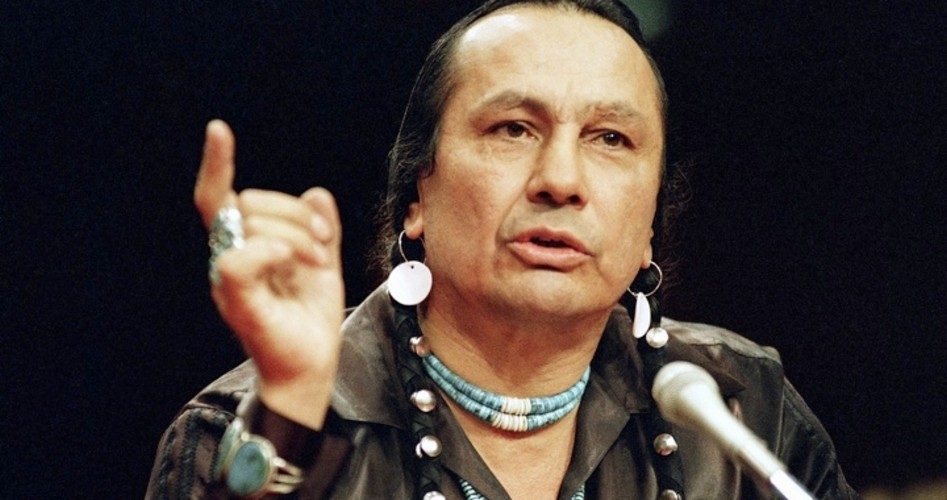
One of the earliest members of the American Indian Movement (AIM) after it was founded in 1969, Russell Means died of natural causes at his ranch in Porcupine, South Dakota, on October 22. Born on South Dakota’s Pine Ridge reservation in 1939, he spent most of his adult life claiming to fight for justice for the American Indians. In reality, he was more a revolutionary who was determined to destroy freedom for all Americans.
AIM was founded in 1969 by Dennis Banks, Clyde Bellecourt, and George Mitchell (not the recently deceased U.S. senator). These three had already earned 42 convictions for assault, armed robbery, and criminal violence. Means soon joined with them and added his own small list of criminal offenses to their total. He gained media attention for himself and AIM by leading a group of Indian protesters who seized control of a replica of the Mayflower in Plymouth, Massachusetts, on Thanksgiving Day 1970. He later attempted to gain control of the Mount Rushmore monument where the heads of four ex-presidents of the United States are carved into the mountainside.
In 1972, Means and his AIM cohorts occupied the Bureau of Indian Affairs in Washington. They ransacked its headquarters causing $3 million in damages but were given $66,000 by federal officials when they were forced out. The federal Office of Economic Opportunity awarded AIM $400,000, and funds were given to the group by the World Council of Churches and other “religious” groups. In 1973, Means and his AIM cronies led hundreds of other recruits in a takeover of the village of Wounded Knee, South Dakota. They occupied the area for more than two months and were eventually forced out after a small war was waged in which several Indians were killed and a federal official was severely wounded.
On September 25, 1973, Means spelled out his and AIM’s revolutionary plan during an AIM rally at the University of Minnesota. Appearing with professed communist Angela Davis at his side, he announced that his goal included separating from the United States and building a new nation within our country’s borders. He stated:
If I become president of the Oglala Sioux tribe of the Pine Ridge Indian Reservation, we will take the first steps to eradicate the United States of America’s influence from our land. The methods, of course, depend on the cooperation of various countries that we are already in the process of talking to; various countries who will recognize our sovereignty and deal with us as international partners.
If their cooperation is assured, then when I become president [of the new country], I will abolish that office. I will abolish the Tribal Council, the Tribal Constitution, the Indian Reorganization Act, the Bureau of Indian Affairs, the Public Health Service, the white ranchers and farmers of the Pine Ridge Reservation.
Then we will sit down in diplomatic negotiation with the United States of America to settle up for the western half of South Dakota….
In his own 1996 book Where White Men Fear to Tread, Means stated, “I planned to kill a few rednecks at random… Most of the whites I wanted dead were U.S. Congressmen, Senators, federal and state appellate judges — the most visible proponents of institutionalized racism.” He noted that he was receiving help from such anti-American groups as the Weather Underground, the Black Panthers, a Chicano group known as the Brown Berets, and the National Lawyers Guild which has long been the legal arm of the Communist Party USA. Through contacts made via these revolutionaries and others, AIM received equipment and political support from Cuba, Red China, the Irish Republican Army and the Palestine Liberation Movement. AIM’s allies even included Libya’s Moammar Ghadafi.
When AIM was exposed as a dangerous, pro-communist, and radical organization in several articles appearing in the John Birch Society-affiliated American Opinion magazine (a predecessor to The New American), and after some of his AIM companions had been sent to prison for killing two FBI agents, Means broke with AIM and turned to other pursuits. In 1987, he tried to secure the Libertarian Party’s 1988 nomination for president but lost to Rep. Ron Paul. He later failed in an attempt to become governor of New Mexico.
Acting became a source of income for the man who wanted to make war on the United States from within our nation’s borders. He had a leading role in a 1992 film entitled The Last of the Mohicans. Overall, he appeared in dozens of films and television productions. Married and divorced four times, he fathered nine children and leaves a fifth wife who partnered with him in 1999.
The story of AIM is one of complicity in revolutionary activity on the part of the U.S. federal government, numerous extreme leftist groups, communists within the United States and abroad, and seemingly respectable religious organizations. If AIM had not been exposed for what it really amounted to by patriotic Americans, its band of criminals might well have started a widespread revolution. It is doubtful that they would ever have succeeded in establishing a foreign entity within our nation’s borders but, with potential recognition from communist nations and even the United Nations, who knows where their movement would have gone? Surely, a lot of blood would have been spilled along with a lot of treasure spent to stop their planned revolution.
Russell Means never retracted his determination to destroy this country. But when his designs were thwarted, he retreated to a semblance of normalcy. An apology that never came from him would have been welcomed.
Photo: In a Jan. 31, 1989 file photo, Russell Means, who headed the American Indian Movement, (AIM) testified before a special investigative committee of the Senate Select Committee in Washington: AP Images



